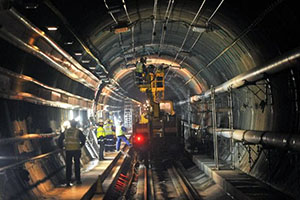
History-Periods
Past eras

From pre-history to today
Choose your period

Periods of History
explore the different eras

The building of the Channel Tunnel, also known as the "Chunnel," was a collaborative effort between various entities from both France and England. Here are the key players involved:
The Governments:
France: The French government, under the presidency of François Mitterrand, showed strong support for the project. Mitterrand believed in the importance of the tunnel for economic integration and improving Franco-British relations.
United Kingdom: The British government, led by Prime Minister Margaret Thatcher initially showed skepticism but later came on board to support the project. The government recognized the potential benefits of the tunnel for trade and tourism.
Company and Consortium:
Eurotunnel: Eurotunnel, formerly known as the Channel Tunnel Group/France-Manche (CTG/F-M), was the private consortium responsible for the construction and operation of the Channel Tunnel. It was created in 1986 and consisted of a group of British and French construction and engineering firms.
Financial Support:
Funding from the Governments: The project received financial support from both the French and British governments. They provided guarantees and loans to Eurotunnel to secure private investment for the construction.
Private Investors: Eurotunnel attracted private investors who contributed funds to the project, including banks, construction companies, and pension funds.
Political Agreement:
The Treaty of Canterbury: In 1986, the British and French governments signed the Treaty of Canterbury, which laid the foundation for the construction and operation of the Channel Tunnel. The key aspects of the treaty included:
Determining the route of the tunnel and associated facilities.
Establishing a binational safety authority to oversee the project's safety standards.
Setting regulations for the operation and maintenance of the tunnel.
Detailing the financial arrangements and guarantees provided by the governments to support the project.
The Treaty of Canterbury was a crucial political agreement that provided the framework for the construction and operation of the Channel Tunnel. It ensured cooperation between France and England in realizing the project's vision and addressing various legal, financial, and safety aspects.
The construction of the Channel Tunnel, a remarkable engineering feat, involved the implementation of various technologies and techniques. Here are some key aspects of the technology and engineering used:
Tunneling Method:
The tunnel was constructed using the "immersed tube" method. Large precast concrete segments were manufactured on land and then floated into position and sunk into a prepared trench at the bottom of the English Channel.
Tunnel boring machines (TBMs) were used to excavate the tunnels under the land sections of the project.
Tunnel Design and Structure:
The Channel Tunnel consists of three tunnels: two main rail tunnels and a smaller service tunnel in between.
Each main rail tunnel is approximately 7.6 meters in diameter and is designed to accommodate trains and their infrastructure, including tracks, signaling, and ventilation systems.
The service tunnel, located between the rail tunnels, provides access for maintenance and emergency services.
Safety Measures:
Safety was a paramount consideration in the design and construction of the tunnel. It involved the implementation of fire safety systems, evacuation procedures, and sophisticated monitoring and control systems.
The tunnel is equipped with emergency escape routes, cross-passages, and extensive fire-resistant measures to ensure the safety of passengers and staff.
Construction Timeline and Cost:
Construction of the Channel Tunnel began in 1988 and was completed in 1994, taking approximately six years to build.
The project faced several challenges, including difficult geological conditions, underwater construction, and coordination between the British and French construction teams.
The total cost of the project was approximately £9 billion (British pounds) or €13 billion (euros) at the time, making it one of the largest infrastructure projects of its kind.
It's important to note that the cost and timeline mentioned are approximate figures and may not account for subsequent maintenance and operational expenses. The Channel Tunnel remains an engineering marvel, serving as a vital transportation link between the United Kingdom and continental Europe.
The concept of building a tunnel under the English Channel, connecting England and France, dates back several centuries. The idea of a fixed link between the two countries has intrigued engineers and visionaries for a long time. Here's a brief history of the concept:
Early Ideas and Attempts:
The first recorded mention of a tunnel under the English Channel was by Albert Mathieu-Favier, a French engineer, in 1802. He proposed the idea to Napoleon Bonaparte, but the project was abandoned due to fears of British invasion.
In the mid-19th century, a French engineer named Aimé Thomé de Gamond proposed a tunneling project, but it faced financial and technical challenges and did not proceed.
Late 19th and Early 20th Century:
In the late 19th century, several tunneling projects were proposed, including a plan by Colonel Sir Frederick Beaumont in 1875. However, these plans remained unrealized.
In the early 20th century, during World War I, both the British and French militaries considered the idea of a tunnel for military purposes. However, the plans were again abandoned due to the war's demands.
Post-World War II Developments:
In 1957, the Channel Tunnel Study Group was formed in France, which aimed to examine the feasibility of a tunnel.
In the 1960s, the idea gained more traction, and in 1964, the Channel Tunnel Study Group published a report recommending a rail tunnel.
In 1973, the British and French governments formed a joint working group to study the project's feasibility. They concluded that a tunnel was technically and financially viable.
Project Development and Construction:
In 1986, the British and French governments signed the Treaty of Canterbury, which outlined the construction and operation of the Channel Tunnel.
Construction began in 1988 and involved three tunnels: two for trains and a smaller service tunnel in between.
The project faced numerous challenges, including geological difficulties, financing concerns, and safety considerations.
The Channel Tunnel was finally completed and opened on May 6, 1994. It is a marvel of engineering, spanning 31 miles (50 kilometers) beneath the English Channel.
The Channel Tunnel, also known as the Eurotunnel, has had a significant impact on transportation and travel between the United Kingdom and continental Europe. It provides a crucial link for both passenger and freight trains, allowing for efficient and rapid transportation between the two countries. The tunnel has played a vital role in enhancing economic and cultural connections and has become a symbol of European integration.
If you have a suggestion regarding additional topics you would like to see included - please let us know
Reference: Article by Greg Scott (Staff Historian), 2024
Tour Reviews
History Attractions
Submit Tour Suggestions
2024 Departures
Spotlight Tours
Events and anniversaries

All content and images are protected by copyright to Access History